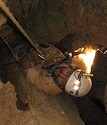Rappelling 300' on 8mm rope with a micro rack?
Moderator: Tim White
17 posts
• Page 1 of 2 • 1, 2
Rappelling 300' on 8mm rope with a micro rack?
As a canyoneer venturing into the caving world I have a few questions about racks and their use with smaller diameter ropes. When doing remote first descent canyons in Death Valley we generally do not take large diameter ropes due to weight. Before I got into caving I would use a petzl pirana to rappel down 300’ free hanging rappels on 8mm rope. Others in my group would use ATC’s with two biners at the clip in point to help pinch the rope and increase friction. This combination lead to hot devices and rope glaze became a real worry for me.
I am interested in using a CMI Hyper Rack Extreme which is a small U rack comprised of 2 normal bars and 2 hyper bars. I would prefer not to carry my SMC full rack with 6 bars due to weight. From my limited knowledge of racks this looks to be the best option for descending 300’ on 8mm rope. I understand the risk of micro racks and the safety hazard of feeding rope and potentially having the lower bar disengage putting you on only two bars.
Has anyone had experience rigging these small racks on small diameter ropes? Does the caving community have any better ideas for rapelling 300’ on 8mm rope in a safe and controlled manner that will not build up excessive heat? My current method of using a petzl pirana is unacceptable in my opinion and I’d like to switch to a different setup.
Thanks, Randy.
I am interested in using a CMI Hyper Rack Extreme which is a small U rack comprised of 2 normal bars and 2 hyper bars. I would prefer not to carry my SMC full rack with 6 bars due to weight. From my limited knowledge of racks this looks to be the best option for descending 300’ on 8mm rope. I understand the risk of micro racks and the safety hazard of feeding rope and potentially having the lower bar disengage putting you on only two bars.
Has anyone had experience rigging these small racks on small diameter ropes? Does the caving community have any better ideas for rapelling 300’ on 8mm rope in a safe and controlled manner that will not build up excessive heat? My current method of using a petzl pirana is unacceptable in my opinion and I’d like to switch to a different setup.
Thanks, Randy.
- Randy88fj62
- Infrequent Poster
- Posts: 7
- Joined: Aug 2, 2012 9:44 am
- Primary Grotto Affiliation: SoCal Grotto
Re: Rappelling 300' on 8mm rope with a micro rack?
300' on 8mm rope with a micro rack is possible. Is it better than a Pirana? Depends on your goal. If your goal is to reduce heat, yes, the micro rack will not get as hot. This is because there is more mass to absorb the heat in the stainless steel tubes. The aluminum Pirana is not as good at storing the heat. The micro rack will also lessen rope twist.
However, heat in a rappel device is best controlled by slowing down. If you're zinging, anything is going to hot. A nice, easy, steady, boring pace will keep any device from getting too hot.
FWIW, I would stick to the Pirana. Evidently, it is working for you. And, it's lighter, smaller and cheap.
However, heat in a rappel device is best controlled by slowing down. If you're zinging, anything is going to hot. A nice, easy, steady, boring pace will keep any device from getting too hot.
FWIW, I would stick to the Pirana. Evidently, it is working for you. And, it's lighter, smaller and cheap.
Scott McCrea
SWAYGO
SWAYGO
-

Scott McCrea - Global Moderator
- Posts: 3198
- Joined: Sep 5, 2005 3:07 pm
- Location: Asheville, NC USA
- NSS #: 40839RL
- Primary Grotto Affiliation: Flittermouse Grotto
Re: Rappelling 300' on 8mm rope with a micro rack?
While I'm not familiar with the CMI, the BMS micro racks -- available with long and short frames, single and dual hyperbars -- are very, very popular among cavers in a variety of settings. I would venture to say that the BMS long-frame, single-hyperbar micro rack is the most popular micro rack among cavers right now; many cavers leave their long-frame racks at home for anything other than deep, free pits. In a general sense, micro-racks are typically more suitable for caving use than a piranha, due to the factors Scott mentioned: stainless friction surfaces will last tremendously longer on gritty rope, and a micro-rack won't tangle the rope as badly.
However, I'd have to caution against using 8mm rope for caving use*, at least anything other than pull-down trips. This is especially true for common canyoneering ropes like Bluewater Canyon Rope (or Canyon Pro) with a particularly soft hand and superstatic core. The exception would be for those who are absolute expert-level riggers and plan to always rig in an "alpine" style with multiple rebelays and deviations to prevent the rope from ever touching the rock. One of the fundamental differences between caving and canyoneering is that we usually end up ascending the fixed ropes we rappelled in on, and I am constantly surprised at how easily "small-diameter" ropes (and ropes with a supple sheath) will fray or cut against limestone while climbing.
The small diameters and polyester sheaths that make for very nice canyoneering ropes often make for very, very bad caving ropes.
* The only 8mm nylon/nylon caving ropes I'm aware of are made by Cancord and Beal, and even Beal hedges their bets by referring to the 8mm Antipodes, anecdotally, as "accessory cord" here.
However, I'd have to caution against using 8mm rope for caving use*, at least anything other than pull-down trips. This is especially true for common canyoneering ropes like Bluewater Canyon Rope (or Canyon Pro) with a particularly soft hand and superstatic core. The exception would be for those who are absolute expert-level riggers and plan to always rig in an "alpine" style with multiple rebelays and deviations to prevent the rope from ever touching the rock. One of the fundamental differences between caving and canyoneering is that we usually end up ascending the fixed ropes we rappelled in on, and I am constantly surprised at how easily "small-diameter" ropes (and ropes with a supple sheath) will fray or cut against limestone while climbing.
The small diameters and polyester sheaths that make for very nice canyoneering ropes often make for very, very bad caving ropes.
* The only 8mm nylon/nylon caving ropes I'm aware of are made by Cancord and Beal, and even Beal hedges their bets by referring to the 8mm Antipodes, anecdotally, as "accessory cord" here.
"Although it pains me to say it, in this case Jeff is right. Plan accordingly." --Andy Armstrong
-

Jeff Bartlett - NSS Hall Of Fame Poster
- Posts: 948
- Joined: Jun 29, 2007 12:19 am
- Location: Chattanooga, TN
- Name: Jeff Bartlett
- NSS #: 59325
- Primary Grotto Affiliation: Tennessee Cave Survey
Re: Rappelling 300' on 8mm rope with a micro rack?
Scott,
You are correct in that slowing down would help reduce the heat and then I could continue to use the pirana. I am 6’5”, 200 lbs. With a 30 lb pack that puts me at 230 lbs for my descender to deal with. We typically descend 5,000 vertical feet in a day with about 35 rappels. Most drops are below 200 ft and contain little to no overhang. This is where the pirana shines and works well. For the longer drops I am hoping to use the micro rack which will allow a reasonable descent speed with a whole bunch of extra friction to add on the fly.
I agree that 8mm ropes have no place in caves. For canyoneering I hate the bluewater ropes. Their high elongation percentage gives a bouncy ride. Most of the people I canyon with use Imlay ropes which are stiff and have an unusually thick sheath which protects us from cutting through the rope during longer descents.
You are correct in that slowing down would help reduce the heat and then I could continue to use the pirana. I am 6’5”, 200 lbs. With a 30 lb pack that puts me at 230 lbs for my descender to deal with. We typically descend 5,000 vertical feet in a day with about 35 rappels. Most drops are below 200 ft and contain little to no overhang. This is where the pirana shines and works well. For the longer drops I am hoping to use the micro rack which will allow a reasonable descent speed with a whole bunch of extra friction to add on the fly.
I agree that 8mm ropes have no place in caves. For canyoneering I hate the bluewater ropes. Their high elongation percentage gives a bouncy ride. Most of the people I canyon with use Imlay ropes which are stiff and have an unusually thick sheath which protects us from cutting through the rope during longer descents.
- Randy88fj62
- Infrequent Poster
- Posts: 7
- Joined: Aug 2, 2012 9:44 am
- Primary Grotto Affiliation: SoCal Grotto
Re: Rappelling 300' on 8mm rope with a micro rack?
Randy88fj62 wrote:I agree that 8mm ropes have no place in caves. For canyoneering I hate the bluewater ropes. Their high elongation percentage gives a bouncy ride.
Very good. Also, you just described the reason why most of us prefer 11mm PMI to 11mm Bluewater II. :)
"Although it pains me to say it, in this case Jeff is right. Plan accordingly." --Andy Armstrong
-

Jeff Bartlett - NSS Hall Of Fame Poster
- Posts: 948
- Joined: Jun 29, 2007 12:19 am
- Location: Chattanooga, TN
- Name: Jeff Bartlett
- NSS #: 59325
- Primary Grotto Affiliation: Tennessee Cave Survey
Re: Rappelling 300' on 8mm rope with a micro rack?
There's no reason why you couldn't use a 4 bar micro rack with 2 hyper bars on 8 mil and be just fine.
One thing to keep in mind is rappell safeties, if (when) you use them. As I'm sure you know there are braking positions with the micro rack, as with bobbin style devices, in which your hand position does not allow for a safety. Naturally, this would be something you would want to have figured out before your drop.
Though, lately, my rappell device of choice has been a steel carabiner. My Simple just got to clunky
One thing to keep in mind is rappell safeties, if (when) you use them. As I'm sure you know there are braking positions with the micro rack, as with bobbin style devices, in which your hand position does not allow for a safety. Naturally, this would be something you would want to have figured out before your drop.
Though, lately, my rappell device of choice has been a steel carabiner. My Simple just got to clunky
Your words of caution are no match for my disaster style!
-

chh - NSS Hall Of Fame Poster
- Posts: 522
- Joined: Oct 4, 2005 3:21 pm
- Location: asheville, nc
- Name: caleb
- NSS #: 55745
Re: Rappelling 300' on 8mm rope with a micro rack?
BTW. 8 mil ropes definitely have a place in caving provided the rigging is suitable, like Jeff said. I LOVE skinny ropes. I'd rather carry the bolt kit in once and do a good job so that everyone else can save weight on subsequent trips.
I'm waiting for textiles and design to evolve to the point where I can carry all the rope I need in a nalgene bottle and my rap device is not much bigger than an expensive wristwatch and clutched so it doesn't rely on rope friction. Hey, a guy can dream right? I mean, James Bond can totally do it on a monofiliment why can't we?
Oh yeah, and where's my freaking hoverboad?!?!?!?
I'm waiting for textiles and design to evolve to the point where I can carry all the rope I need in a nalgene bottle and my rap device is not much bigger than an expensive wristwatch and clutched so it doesn't rely on rope friction. Hey, a guy can dream right? I mean, James Bond can totally do it on a monofiliment why can't we?
Oh yeah, and where's my freaking hoverboad?!?!?!?
Your words of caution are no match for my disaster style!
-

chh - NSS Hall Of Fame Poster
- Posts: 522
- Joined: Oct 4, 2005 3:21 pm
- Location: asheville, nc
- Name: caleb
- NSS #: 55745
Re: Rappelling 300' on 8mm rope with a micro rack?
I have talked with rappellers who've done much bigger drops than I have (in the multi-thousands of feet range) who mentioned squirting water onto their descender throughout the rappel, so that heat energy is expended in the process of evaporating the water. I have not tried this personally, as I'm of the "go slow and carry a BFR" camp, but you'd obviously want to ensure doing it in a way that wouldn't compromise your controlled descent (perhaps lock off with an autobloc first?) and would want to use as little water as necessary so as not to wind up soaking the rope.
-

driggs - NSS Hall Of Fame Poster
- Posts: 495
- Joined: Sep 12, 2005 9:40 pm
- Location: State of Jefferson
- Name: David A. Riggs
- NSS #: 56189
- Primary Grotto Affiliation: Monongahela
Re: Rappelling 300' on 8mm rope with a micro rack?
I recently bought a dual-hyper micro-rack. So I played with it in canyon with some 8mm CanyonPro DS on Thursday. Rope was soon wet.
The rack worked pretty well but I wouldn't describe it as a "whole bunch of extra friction". At just under your weight I wasn't impressed with the granularity of friction settings in the higher ranges. But then, I'd say the same for the ATS (which I consider superior to the piranha in that regard).
Stupid gotcha: When loading the rope into the two devices - ATS/Pirhanas are fed through the bottom first, my rack is fed from the top. I kept trying to rig the rack of death from muscle memory.
The rack worked pretty well but I wouldn't describe it as a "whole bunch of extra friction". At just under your weight I wasn't impressed with the granularity of friction settings in the higher ranges. But then, I'd say the same for the ATS (which I consider superior to the piranha in that regard).
Stupid gotcha: When loading the rope into the two devices - ATS/Pirhanas are fed through the bottom first, my rack is fed from the top. I kept trying to rig the rack of death from muscle memory.
-

davantalus - Occasional Poster
- Posts: 45
- Joined: Dec 17, 2009 10:30 am
- Location: Los Angeles, CA
- Name: Dav Angel
- NSS #: 63392
- Primary Grotto Affiliation: SoCal Grotto
Re: Rappelling 300' on 8mm rope with a micro rack?
Change ropes...get the technora stuff which deflects heat much better than polyester or nylon which melt unless you go painfully slow no matter what device you use. I'd use the micro rack and 8mm Canyon X or similar rope, look for a very static one so you can save wear(a bouncy rope saws through easier). A SS device generally has less friction, but it is much more durable and won't wear through as badly in sandy conditions. I can just see getting partway down a canyon and having a half eaten aluminum device that I no longer trust 

-

Vertigo - NSS Hall Of Fame Poster
- Posts: 500
- Joined: Sep 28, 2006 8:06 pm
- Location: Chattanooga, TN
Re: Rappelling 300' on 8mm rope with a micro rack?
I admittedly have not kept up on rope technology in the last few years, but as I recall technora was an aramid (kevlar like) fiber developed for high heat applications. While it excelled in heat resistance and tensile strength, it was generally poor with respect to shock loads and was very seriously degraded when knotted. It was popular for footloops and the like, and if you had a good chance of rappeling from a burning building, then it was the way to go. It also had issues with degrading over time.
Certainly newer versions may have overcome these limitations. However, does anyone have good info on technora in life-support caving applications?
If "painfully slow" is how you describe rappels below the melting point of nylon, well......
BTW the friction heat from a rappel WILL go somewhere, and if it isn't in the rope it will be the rack. I'd say having cool rope but a rack hot enough to melt through your chest harness might be a poor trade
Certainly newer versions may have overcome these limitations. However, does anyone have good info on technora in life-support caving applications?
If "painfully slow" is how you describe rappels below the melting point of nylon, well......
BTW the friction heat from a rappel WILL go somewhere, and if it isn't in the rope it will be the rack. I'd say having cool rope but a rack hot enough to melt through your chest harness might be a poor trade

I'm not scared of the dark, it's the things IN the dark that make me nervous. :)
-

wyandottecaver - NSS Hall Of Fame Poster
- Posts: 2902
- Joined: Aug 24, 2007 8:44 pm
- Location: Indiana
Re: Rappelling 300' on 8mm rope with a micro rack?
davantalus wrote:I recently bought a dual-hyper micro-rack. So I played with it in canyon with some 8mm CanyonPro DS on Thursday. Rope was soon wet.
The rack worked pretty well but I wouldn't describe it as a "whole bunch of extra friction". At just under your weight I wasn't impressed with the granularity of friction settings in the higher ranges.
A microrack -- and for that matter, a full-sized rack with hyperbar -- has practically zero friction adjustment range once you've engaged the hyperbar, because doing so compresses the rappel bars to their maximum friction (closest proximity to each other) setting. The long frame microrack has a surprising range of friction available so long as the hyperbar is not engaged, though it is more sensitive to "extremes" than some other descenders: too much friction with an especially light rappeller and/or thick, stiff, muddy rope; too little friction with an especially heavy rappeller/load and/or thin, soft, fast rope. You can rappel with the hyperbar engaged for max friction in the latter case; the options for the former are either mindful feeding or anticipating the high-friction scenario before rigging in, and rigging the rack in a two-bars-plus-hyperbar configuration, which is for very experienced users only (and likely not at all recommended by the manufacturer).
-

driggs - NSS Hall Of Fame Poster
- Posts: 495
- Joined: Sep 12, 2005 9:40 pm
- Location: State of Jefferson
- Name: David A. Riggs
- NSS #: 56189
- Primary Grotto Affiliation: Monongahela
Re: Rappelling 300' on 8mm rope with a micro rack?
2bars plus hyper can be done safely....but so can smoking while sitting on a can of gasoline... if your that light carry someone's pack and add a bar! :)
I'm not scared of the dark, it's the things IN the dark that make me nervous. :)
-

wyandottecaver - NSS Hall Of Fame Poster
- Posts: 2902
- Joined: Aug 24, 2007 8:44 pm
- Location: Indiana
Re: Rappelling 300' on 8mm rope with a micro rack?
driggs wrote:davantalus wrote:I wasn't impressed with the granularity of friction settings in the higher ranges.
A microrack -- and for that matter, a full-sized rack with hyperbar -- has practically zero friction adjustment range once you've engaged the hyperbar
A good point. I guess what I was trying to say was that with a full pack, belly, and some wet 8mm rope I felt like I was looking for a setting between mini-all-bars and mini-hyperbar-engaged.
No fault of the minirack - with 11mm (or dry 8mm) rope it would perfect for me. I've switched back to an ATS for most canyon applications.
-

davantalus - Occasional Poster
- Posts: 45
- Joined: Dec 17, 2009 10:30 am
- Location: Los Angeles, CA
- Name: Dav Angel
- NSS #: 63392
- Primary Grotto Affiliation: SoCal Grotto
Re: Rappelling 300' on 8mm rope with a micro rack?
Has anyone tried spacers on a micro rack? As has been said on this thread, with the hyperbar engaged there is no friction adjustment available which makes for a SLOW descent (for me) on 11mm rope. This summer I took my micro rack into Main Drain instead of my usual SMC full rack and I had to practically force myself down the rope even though with a pack (I'm about 160lbs), which turned one of my favorite vertical caves into, well, not as much fun. Though to be honest a lot of the project ropes in there are swollen 11mm.
-

gindling - NSS Hall Of Fame Poster
- Posts: 235
- Joined: Nov 17, 2008 3:40 pm
- Location: Montana
- NSS #: 53629
- Primary Grotto Affiliation: Northern Rocky Mountain Grotto
17 posts
• Page 1 of 2 • 1, 2
Who is online
Users browsing this forum: No registered users

